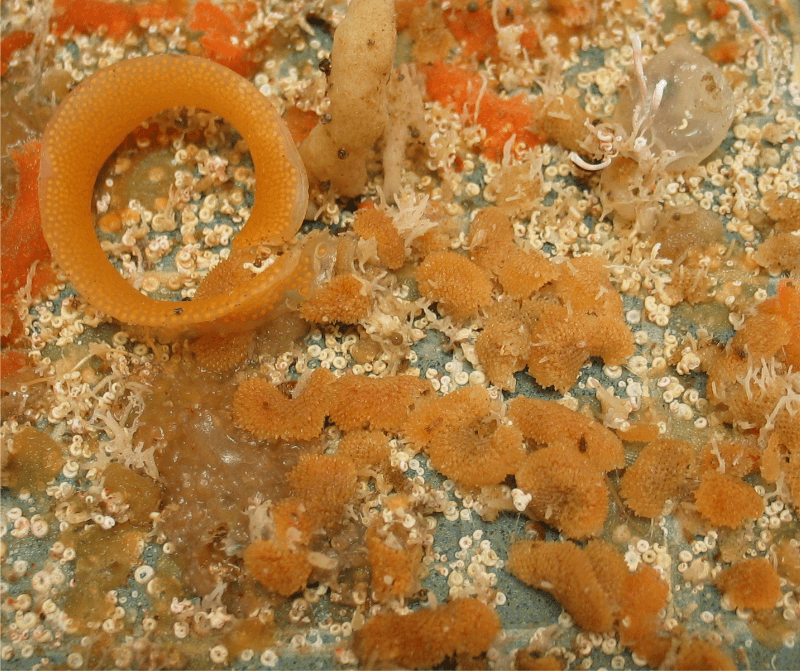
The oceans are being impacted by climate change from rising atmospheric CO2 levels and increasing pollution (e.g. petroleum hydrocarbons and heavy metals) from human activities, leading to increases in seawater temperature and changes in ocean chemistry (e.g. pH decrease or ocean acidification). Ocean acidification and pollution threaten marine calcifiers such as corals, bryozoans, molluscs, and plankton that build their calcium carbonate (CaCO3) skeletons/shells, by making it harder to make skeletons/shells (less carbonate in seawater) or even making seawater corrosive to some species when carbonate levels fall below saturation points.
Some species can incorporate high amounts of magnesium (Mg) into their calcified skeletons, making them even more soluble, and they are therefore potentially more susceptible to pH decrease. CO2 is much more soluble in cold waters, which can sequester more atmospheric CO2, resulting in more rapid rates of acidification in polar waters, and lower pH and concentrations of carbonate ions (CO32-).
In addition, organisms at high latitudes show slower metabolism, growth, and larval development and consequently have slower detoxification processes and slower colonisation rates. Marine calcifiers living in polar regions may therefore be more vulnerable to ocean acidification, which when combined with other stressors such as contamination, could have negative synergistic effects. These organisms are important components of marine ecosystems and can act as ecosystem engineers by creating calcareous reef habitats that are used as a shelter, substrate, and food for many benthic organisms.
Bryozoans and spirorbids are marine calcifiers found in many marine benthic habitats. Individually, both are small filter feeders but bryozoans generally live in sessile colonies with a broad spectrum of calcified shapes (ranging from encrusting sheets to erect branching coral-like structures), while spirorbids are sessile worms that usually build tiny white spiral tubes. In places, however, these tiny tubes can cover the substratum or even heavily colonize other biota such as algae or other calcifiers.
For the first time, we examined the spatio-temporal variability of Mg content in the skeletons of common Antarctic bryozoans and spirorbids. These were attached to settlement plates (tiles) recovered after 3 and 9 years of their deployment in human-impacted and non-impacted areas around Casey Station in East Antarctica. These kinds of experiments contribute to our understanding of how different environmental and anthropogenic factors may potentially affect their skeletons in future oceans with higher CO2 and lower pH. Significant spatial variability was found in the skeletal Mg content in some species, which could reflect local environment variation in variables that influence calcification. For example, freshwater input from summer ice melt (that can also carry contaminated sediments into the sea) can affect seawater chemistry and, consequently, the ability of marine calcifiers to build their shells.
It has been previously demonstrated that contaminated sediments have impacted benthic communities in the same area these settlement tiles were deployed, but we found no evidence to suggest this contamination is affecting the mineralogy of the calcifiers in these areas. Interestingly, we did not find any significant temporal variation in skeletal mineralogy within species over the 6 year period, suggesting these species could be suitable long-term indicators of the potential effects of environmental change. Now that we have an understanding of how spatially and temporally variable they are, further research, such as laboratory experiments, is needed to understand how their mineralogy responds to environmental changes.
These findings are described in the article entitled Spatio-temporal variation of skeletal Mg-calcite in Antarctic marine calcifiers, recently published in the journal PLOS One.
References:
- Millero F, Woosley R, DiTrolio B, Waters J. Effect of Ocean Acidification on the Speciation of Metals in Seawater. Oceanography. 2009;22: 72–85.
- Fabry V, McClintock J, Mathis J, Grebmeier J. Ocean Acidification at High Latitudes: The Bellwether. Oceanography. 2009;22: 160–171
- Chapman PM, Riddle MJ. Missing and needed: Polar marine ecotoxicology. Marine Pollution Bulletin. 2003;46: 927–928.
- Orr JC, Fabry VJ, Aumont O, Bopp L, Doney SC, Feely R a, et al. Anthropogenic ocean acidification over the twenty-first century and its impact on calcifying organisms. Nature. 2005;437: 681–686.
- Andersson AJ, Mackenzie FT, Bates NR. Life on the margin: Implications of ocean acidification on Mg-calcite, high latitude and cold-water marine calcifiers. Marine Ecology Progress Series. 2008;373: 265–273.
- Stark JS. Patterns of higher taxon colonisation and development in sessile marine benthic assemblages at Casey Station, Antarctica, and their use in environmental monitoring. Marine Ecology Progress Series. 2008;365: 77–89.









